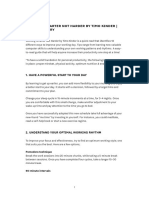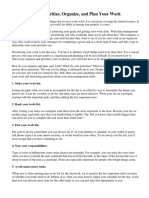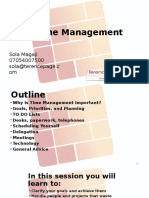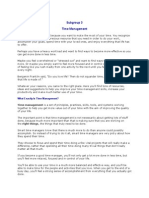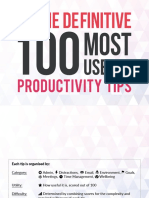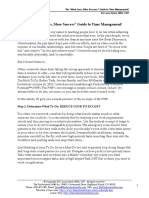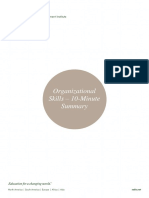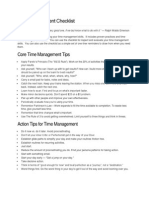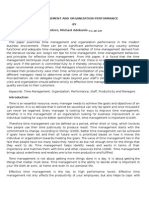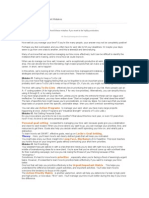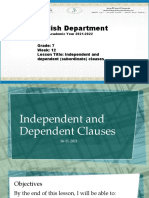Task and Work Load Management:
The five-step guide to workload management
1. Put together a full list of projects and processes your team is responsible for.
2. Determine the scope and timing of work for each.
3. Break down projects into smaller tasks and workstreams
4. Prioritize work based on importance and urgency.
5. Monitor schedules and projects regularly.
�TEN TIPS FOR MANAGING YOUR WORKLOAD
We all experience it. That overwhelmed feeling that comes over us as work stacks
up, seemingly on end. We push ourselves to get through the pile, only to find that
another one has sprouted up behind it.
Sometimes the workload can seem so heavy that it can be intimidating to get started.
The good news is that when you take a deep breath, step back, and examine your
workload; you can take some simple steps to get out from under it and get back to
crushing it.
1. KNOW THE STRATEGY AND SET GOALS ACCORDINGLY
What are the goals of the business, and what strategy is being deployed to
accomplish them? Starting with an understanding of the strategy, your boss’
expectations and your role within them can help you set goals accordingly. Set your
daily, weekly, monthly, and quarterly goals and tactics so that your actions work to
achieve those targets. Reflect on what will bring the greatest value to your team and
your organization and diligently protect the time, attention, and resources needed to
accomplish them. If something isn’t aligning to the strategy, question its importance
and urgency and determine if it should be delegated or discarded altogether.
2. SCHEDULE YOUR TIME BASED ON YOUR PRIORITIES
Knowing the strategy and setting goals around that will clarify your highest priorities.
Set aside 30-50% of your time to work on tasks and activities that will help you
achieve the goals. It’s easy to get distracted by fires or pulled into other people’s
projects. When you block out time to meet your goals first, rather than helping
everyone else, you take back your ownership of your time - an action that will help
prevent any feelings of overwhelm in the first place. Consider strategies such as
calendar blocking, closed-door, and shutting down email.
3. BE SELECTIVE AS TO WHAT MEETINGS YOU ATTEND
Not every meeting is a good fit for your time. Question every meeting that comes
your way by asking how critical it is for you to attend and what is your role. Perhaps
ask someone else attend on your behalf. Use a best, better, and good approach by
�dividing your work and meeting times into these three categories and focusing at
least 40-60% of your time on the 2-3 strategic priorities (the best), and dividing the
rest of your time between the improvement efforts and new ideas (the better) and the
daily maintenance follow up activities (the good).
4. LET THINGS DROP OFF YOUR TO-DO LIST
It’s okay to let some things go! If something has been on your to-do list for a long
time, and you can’t seem to find time to get around to it, it’s likely not critical. Drop
that task from your to-do list and move on. You can record the idea someplace if it is
something you eventually want to do, but avoid having it on your daily, weekly, or
monthly to-do list as it will fester there.
5. MANAGE YOUR INBOX
Use the two-minute rule to manage your inbox. If it takes you two minutes or less,
deal with it right now. Your action may be responding to the message, filing it into a
folder, or sharing it with another colleague. The goal is to move as many things as
you can out of your inbox during your scheduled email time. You can prevent an
email backlog and mounting pressure on your to-do list when you follow this process.
Consider applying this same rule to emails you send. Can the receiver satisfy your
request in two minutes?
6. TAKE BREAKS
We cannot perform at our best when we are not taking care of our physical needs. It
may seem counterintuitive when you are knee-deep in work, but getting up to move,
eat, or drink water can be just the thing you need to give you the energy to surge
ahead. Likewise, taking the time to breathe and reflect provides insight into what you
are doing and will provide you with an opportunity to have a eureka moment. An
important note on taking a break - manage your sleep. It’s easy to get into a cycle of
overwhelm when we are not getting the rest we need. Sometimes having an early
night is all we need to tackle the next day.
7. ASK QUESTIONS BEFORE SAYING YES
Get the details of a project or a request before agreeing to it. Knowing what the
expected deadlines are in advance can help you set expectations, schedule your
time, or let others know that you will not be able to meet a deadline. Having all of the
�necessary details will give you space to dive into the project without waiting for more
information, making it easier for you to accomplish the work in the time you have
carved out for it. If you have to say no, perhaps you have a referral name that may
jump at the opportunity.
8. ALIGN HOW YOU SPEND YOUR TIME WITH WHAT YOU VALUE
As you come home each day and look in the mirror, are you proud of what you are
accomplishing each day? Does your work each day align with what you consider to
be important? Aligning your values with the needs of your job, team, and
organization creates a powerful filter to prioritize your workload and manage your
stress. This perspective enables you to consider your professional aspirations, your
desired work-life integration, and what activities energize you as you balance your
day-to-day work. Aligning your work and life goals around what you value the most,
can help clarify what to pay attention to and what to let go, helping you be more
productive on what matters most to you, your family, and your organization.
9. ASSIGN VALUE OF IMPORTANCE AND EFFORT TO TASKS
Rank your tasks in order of importance and effort and then determine what you must
do now, what you can or should delegate, what you can delay, and what you can
drop. Organizing your tasks in this manner provides you with insight into your to-do
list. You can anticipate how much time things will take based on the effort required,
and then focus on those tasks that have the highest value or those requiring your
expertise.
10. MANAGE INTERRUPTIONS
Block out your time and protect it. For every interruption of your work, it takes
approximately 15 minutes to get back into the “zone” and do your best work. Let your
team know when you need to focus and schedule times that you can be interrupted.
Many find it best to create an untouchable period of the day, while others schedule
smaller chunks of time into their calendar that cannot be interrupted.
Getting snowed-under at work is a familiar situation for most of us. Use these ten tips
to structure and prioritize your work while minimizing unnecessary stress or feelings
of burnout. You’ll not only be more effective and productive utilizing these strategies,
but more fulfilled in your role and accomplishments.
